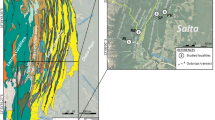Abstract
Based on paleomagnetic measurements and morphostratigraphy of red bed/clay sequences from pediments of the Liupan Shan and the Longdong Basin, the following results are revealed. The red bed/clay sediments became to accumulate at around 8.1 MaBP, which implied that the plantation surface developed since Late Cretaceous was broken by active fault, and its development was terminated. The Liupan Shan began to slightly uplift. The Liupan Shan experienced a small-scale uplift around 5.2 MaBP, inferred from the appearance of fine gravel sediments at that time. Consequently, a pediment was developed. The Liupan Shan accelerated uplift since about 3.8 MaBP at a large scale, which caused the deep incision of the rivers and the termination of fluvial and lacustrine deposition. Meanwhile, typical eolian red clay appeared since then. This uplift process is well correlated and in response to that of the Tibetan Plateau and the mountains around it.
Similar content being viewed by others
References
Zhang, P. Z., Burchfiel, B. C., Molar, P. et al., Amount and style of late Cenozoic deformation in the Liupan Shan area, Ningxia Autonomous Region, China, Tectonic, 1991, 10(6): 1111–1129.
Xiang, H. F., Guo, S. M., Zhang, B. L. et al., Active features of the eastern Liupan Shan pediment reverse fault zone since late Quaternary. Seismology and Geology (in Chinese), 1998, 20(4): 321–327.
Li, Y. L., Hou, Z. Q., Kang, Z. M., Seismology division in Shaanxi, Gansu provinces and Ninxia Hui Autonomous Region in Northwestern China (in Chinese), Lanzhou: Gansu People’s Press, 1986, 86.
Huo, F. C., A Brief Induction of Ninxia Geology (in Chinese), Beijing: Science Press, 1989, 287–288.
Tapponnier, P., Meyer, B., Avouac, J. P. et al., Active thrusting and folding in the Qilian Shan, and decoupling between upper crust and mantle in northeastern Tibet, Earth and Planetary Science Letters, 1990, 97: 382–403.
Evans, M. E., Wang, Y., Rutter, N. W. et al., Preliminary magnetostratigraphy of the red clay underlying the loess sequence at Baoji, China, Geophysical Research Letters, 1991, 18: 1409–1412.
Sun, D. H., Shaw, J., An, Z. S. et al., Magnetostratigraphy and paleomagnetic interpretation of a continuous 7.2 Ma Late Cenozoic eolian sediments from the Chinese Loess Plateau, Geophysical Research Letters, 1998, 25: 85–88.
Cande, S. C., Kent, D. V., Revised calibration of the geomagnetic polarity timescale for the Late Cretaceous and Cenozoic, Journal of Geophysical Research, 1995, 100(B4): 6093–6095.
Li, J. J., Fang, X. M., Uplift of Qinghai-Xizang Plateau and environmental change, Chinese Science Bulletin, 1999, 44(23): 2217–2224.
Lü, L. Q., Fang, X. M., Mason, J. A. et al., The evolution of coupling of Asian winter monsoon and high latitude climate of Northern hemisphere: grain evidence from 8.1 Ma loess-red clay sequence on the Chinese central Loess Plateau, Science in China, 2001, 44(Supp.): 185–191.
Song, Y. G., Fang, X. M., Li, J. J. et al., Age of red clay at Chaona section near eastern Liupan Mountain and its tectonic significance, Quaternary Science (in Chinese), 2000, 20(5): 463–468.
Guo, Z. T., Peng, S. Z., Hao, Q. Z. et al., Late Tertiary development of aridification in Northwestern China: Link with the Arctic ice-sheet formation and Tibetan uplifts. Quaternary Science, 1999, 19(6): 556–567.
Li, J. J., Fang, X. M., Rob, V. D. V. et al., Late Cenozoic magnetostratigraphy (11-0 Ma) of the Dongshanding and Wangjiashan sections in the Longzhong Basin, western China, Geolgie en Mijnbouw, 1997, 76: 121–134.
Zhou, T. X., Wang, L., Cao, M. Z., The formation and development of Ningxia tectonic geomorphic pattern. Acta Geographica Sinica (in Chinese), 1985, 40(3): 215–223.
Harrison, T. M., Copeland, P., Kidd, W. S. et al., Raising Tibet, Science, 1992, 255: 1663–1670.
Fang, X. M., Zhao, Z. J., Li, J. J. et al., Late Cenozoic Magnetostratigraphy in Jiuxi Basin near the northern edge of Qilian Mountain and its implication for the uplift of Tibet, Science in China, Ser. D, 2002, in the press.
Fang, X. M., Li, J. J., Zhu, J. J. et al., The absolute age and division of Cenozoic stratum from the Linxia Basin in Gausu Province. Chinese Science Bulletin (in Chinese), 1997, 42(14): 1457–1471.
Cochran, J. R., Himalayan uplift, sea level, and the record of Bengal Fan sedimentation at the ODP leg 116 site, Proceeding ODP Science Results, 1990, 116: 397–414.
Aagr, S. M., Kiltgord, K. D., Rift flank segmentation, basin initiation and propagation: a neotectonic example from lake Baikal, Journal of Geology Society London, 1995, 152: 849–860.
Burbank, D. W., Reynolds, G. H., Sequential late Cenozoic structural disruption of the northern Himalayan foredeep, Nature, 1984, 311: 114–118.
Author information
Authors and Affiliations
Rights and permissions
About this article
Cite this article
Song, Y., Fang, X., Li, J. et al. The Late Cenozoic uplift of the Liupan Shan, China. Sci. China Ser. D-Earth Sci. 44 (Suppl 1), 176–184 (2001). https://doi.org/10.1007/BF02911985
Received:
Issue Date:
DOI: https://doi.org/10.1007/BF02911985




